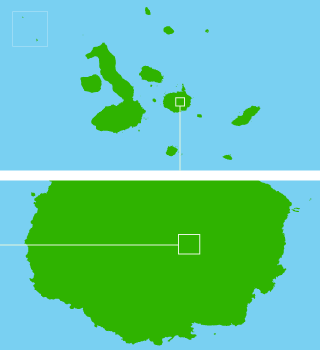

| PUNTUDO / CERRO CROCKER |
Santa Cruz Island |

Permitted Uses:  Interpretive and educational tours Interpretive and educational tours  Photography and filming Photography and filming

It is an open area, but for safety it is better to stay on the paths used normally.
Beyond Media Luna is El Puntudo and Cerro Crocker, the highest peak of the island and is 860 m high. If you wish to walk, it should only be done in good weather. It is easy to get lost, so make sure that the guide knows the path.
If you encounter cattle in the area of the park, please inform the office of Puerto Ayora, at the earliest opportunity.
In the rainy season, the path in the agricultural area is very muddy, inform visitors about the terrain and the need for shoes with good traction.
Do not take fruit whose seeds can fall and germinate. If taking food, make sure waste is not left behind. Everything has to be collected and brought back to port.
Do not disturb the birds that nest here. The Galapagos Petrel (pata pegada), Pterodroma phaeopygia, and Galapagos Rail, Laterallus spilonotus, nest at ground level.
The problems of introduced plants are evident here. Cinchona trees succirubra (cascarilla) and Psidium guajaba (guava) have spread from the agricultural area. Its eradication requires an intense and expensive effort. However, until 1999 45 hectares of Cinchona trees have been remove.
The Miconia robinsoniana (cacaotillo) and other native vegetation have been victims of voracious fires that originated on the farms, livestock loose living in areas of the park, and competition with introduced plants much stronger. This endemic plant is almost extinct in San Cristobal (the only other island where it exists) and here it has been drastically reduced. Its red color during the garúa season gives upper Santa Cruz a striking appearance when seen from afar.
The Galapagos Rail, Laterallus spilonotus, is a bird endemic to Galapagos, common in the area near Media Luna, but very difficult to see because their habitat is under the dense vegetation on the surface of the earth. This bird can barely fly.
Cerro Puntudo is an old splatter type cone, while the other cones in the area are of slag and tuff type. Splatter cones are formed when lava is expelled with great force in a liquid state and splash around. The organic volcanic cinder cones (tuff) are formed in the presence of water and oxygen.
When the molten lava combines with water a very strong freatomagmática explosion is produced and thousands of small particles (ash) are tossed out, deposited near the vent forming the typical cone shape. The cinder cones, however, contain many gases and therefore the material is very light. Being expelled from the vent they fall at large distances away, so the cones are low and wide.
The Galapagos Petrel, Pterodroma phaeopygia, is a seabird that nests in upper Santa Cruz, San Cristóbal, Santiago, Floreana and Isabela (Alcedo Volcano). Until recently it was regarded as common species to Hawaii and Galapagos, but genetic studies have shown that these are two different species. It is considered an endangered species as rats, cats, dogs and other feral animals eat both the eggs and chicks and even adult birds. The nests are on the ground, in holes and caves not so accessible to man. Studies to determine the best way to protect nesting sites of these birds have managed a reproductive success of 95% on Floreana and Santa Cruz.
|


![]()


![]()